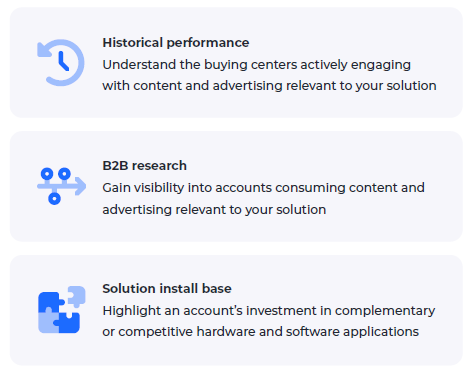
Who are the Buyers of Cybersecurity Solutions?

Success or failure in account-based marketing (ABM) hinges on account prioritization. By focusing on high-value accounts you can create personalized experiences that foster long-lasting customer relationships. To do so, you need to know who these accounts are, who the decision-makers are, and what they care about.
In our ML Insights Data Series, we examine the data on organizations and decision makers within the buying committee who purchase leading B2B technologies today. We’ll use these insights to emphasize changes and deliver recommendations that help marketers prioritize companies and content to increase engagement and conversion.
Why ML Insights?
ML Insights offers B2B marketers the most advanced dataset available, simplifying the identification of in-market accounts, the prioritization of individuals to engage within the organizations, and the content that can accelerate the sales cycle for each audience. We achieve this through the MLI Score, a holistic signal that unifies three key data sources to reveal who’s being targeted, who’s engaging with content, and who is researching solutions so you can go after the accounts with the highest propensity to purchase.
Those three key data sources include:
And when combined with the first-party customer data in your CRM and MAP, marketers using ML Insights gain deeper insights to maximize their marketing spend and accelerate accounts through the buying journey.
Lock up your data! Cybersecurity is a Critical Piece for Your Organization
Verizon, Bed Bath & Beyond, NHS, Amazon, Dropbox… all these brands have one thing in common: they had cybersecurity breaches in Q4 2022. Check Point Research reports a 38% increase in global cybersecurity attacks from 2021 to 2022. Cybercriminals specifically targeted the healthcare industry, hacking patient information and electronic health records.
2022 was a tough year when it came to cybersecurity and experts predict that 2023 won’t be much better. In an article by Forbes Advisor, experts shared the five types of attacks that businesses should be wary of this year:
- Business email attacks – According to the FBI Internet Crime Complaint Center, losses for these attacks resulted in nearly $2.4 billion in 2021.
- Malware and ransomware threats – Remember the Colonial Pipeline ransomware attack? We may see more of this activity, especially with the conflict In Ukraine.
- Crypto Scams and “Pig Butchering” – Posing as friends on apps, criminals persuade victims to invest in cryptocurrencies with false claims of instant returns. These scammers will encourage emptying pockets and then “butcher the pig”, i.e., take all the money out of the account.
- Innovation in laundering and the cash-out process – Criminals will get more creative in cash-out scams to earn money from investments on stocks, crypto; no dollar is safe.
- Scamming as a service – Criminals will set up virtual shops paid for by crypto or some other shady currency to purchase ransomware attacks, confidential information, phishing kits, malware, and more.
Thankfully, businesses are taking notice—Gartner predicts spending on information security and risk management products and services will exceed $188.3 billion in 2023. This opportunity’s most significant growth areas include cloud security, application security, and data privacy.
What Buyers are Searching For
“Data security” was the top topic used in targeting and it was the top search topic engaged with in Q4 2022. Unsurprisingly, most accounts are targeted by cybersecurity solution providers based on “data” – it’s a currency in business. We collect it, mine it, and learn from it. However, we produced a nearly perfect MLI score in targeting and engagement for “IPsec,” a group of protocols that set up encrypted device connections. Given the remote and hybrid workplaces today, businesses are protecting themselves by looking into remote security solutions like IPsec.
Search topics that buyers are researching include the usual suspects: “Internet security,”
“cyberattack,” and “endpoint management.” But we did see a nearly perfect MLI score for “security automation” as well as a 129% increase in “incident and breach management” and a 20% increase in “zero trust.”
Our recommendation: Cybersecurity is important to organizations, and many are interested in preventative solutions that will make their fix easier, I.e., security automation and incident and breach management. Given the higher MLI score for IPsec, this tech is important to buyers, so if providers have a hand in these protocols, they should highlight them in their marketing.
What Accounts to Target
Understanding how in-market accounts are engaging across multiple channels is a key part of a successful ABM strategy. ML Insights gives a granularity of specific account details, providing users a clearer picture of exactly who to target.
Let’s understand which target audiences are best suited for campaigns focused on cybersecurity solutions:
By Vertical
The top three industries targeted by cybersecurity vendors were Manufacturing, Finance, and Technology. Of those three, Manufacturing had a 164% increase in engagement and buyer research for cybersecurity solutions content in Q4 2022. Manufacturing entities that use automation and private networks for system access would be highly concerned about cyberattacks and system security.
Government is an under-targeted vertical that increased buyer research activity by almost 140% in Q4 2022. These organizations are digitally transforming their resources and processes and are prone to attacks like hacking and data breaches. They must keep pace with cybersecurity solutions that can prevent occurrences and disruptions to their operations.
The Healthcare sector has consistently represented significant opportunities for cybersecurity vendors. Many healthcare organizations rely on a range of specialized hospital information systems, including electronic health records (EHR), e-prescribing systems, and practice management support systems, Additionally, thousands of devices that comprise the Internet of Things must be protected as well. Patients, doctors, healthcare workers, and market suppliers are all at risk if a breach in a healthcare facility happens. FBI data reveals that 25 percent of ransomware attacks in 2022 were targeted at the healthcare sector. According to Ivanti, healthcare executives plan on increases in cybersecurity infrastructure and training investments for 2023.
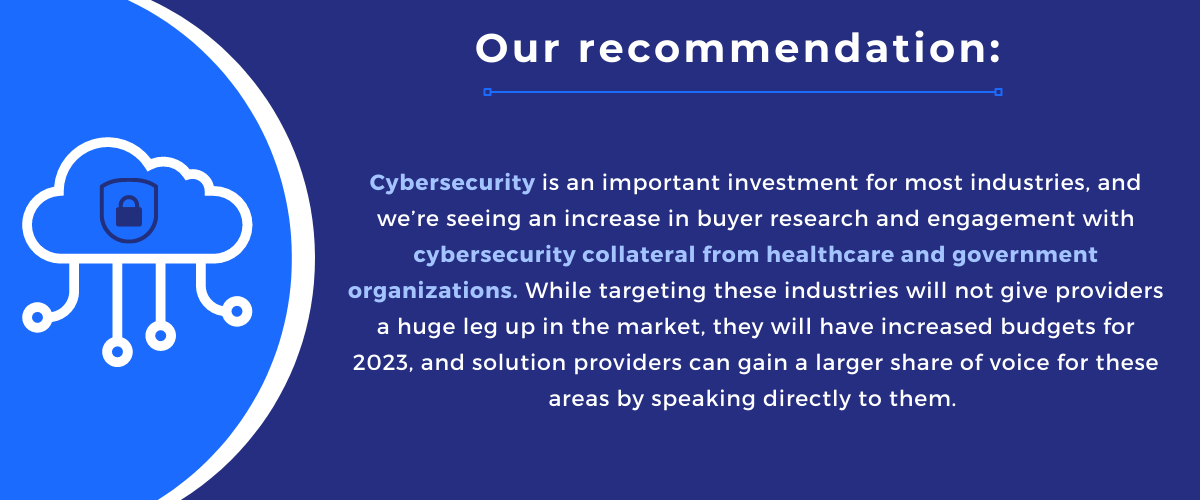
By Company Size
XXL companies (10,000+ employees) are being targeted the most by cybersecurity vendors, and these organizations are also engaging the most with cybersecurity content. ML Insights data reveals a 158% increase in vendors targeting Medium-Small companies (50-199 employees) from Q4 2021 to Q4 2022.
The increased interest in cybersecurity providers targeting small to medium sized businesses (SMBs) has been triggered by the increased reporting on ransomware and hacking incidents. Additionally, some smaller companies are victims of larger hacking rings where attackers can gain access to these SMBs through third parties, like supplier networks. SMBs have more to lose as well and are not equipped like larger companies with cybersecurity experts and expansive infrastructure.
Still, SMBs are not engaging with cybersecurity content as often as larger enterprises, so we can assume that there’s a lack of relevance and personalized outreach for them in existing content. But they’re hungry for it, ML Insights data saw an increase in buyer research behavior from Medium (200-499 employees), Medium-Small (50-199 employees), Small (10-49 employees), Micro-sized (1-9 employees) companies. In fact, these micro-sized organizations increased buyer research by 28% in Q4 2022.
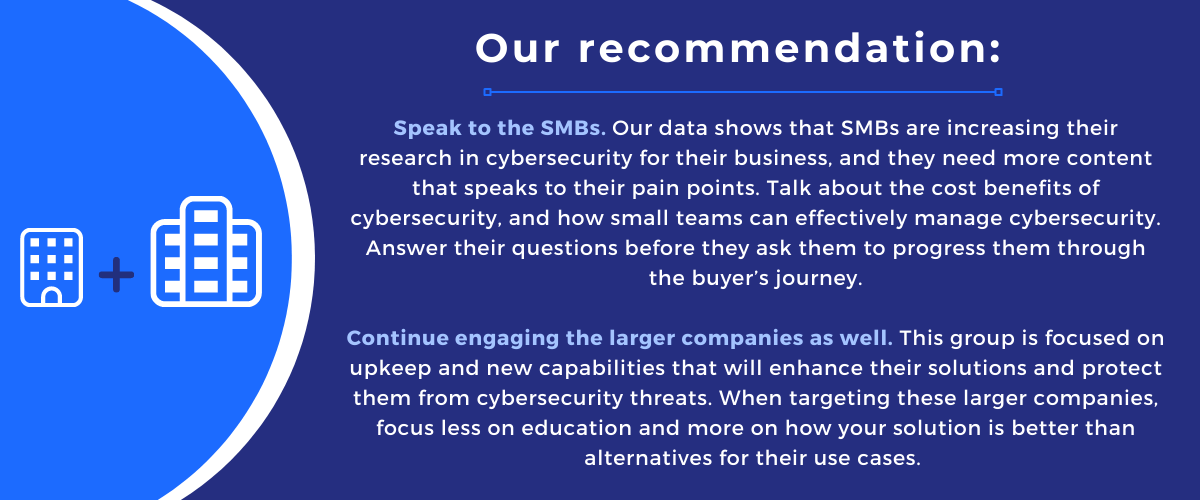
By Region
ML Insights data reveals that EMEA (Europe, Middle East, Africa)-based organizations are most targeted and engaging with cybersecurity content. North America (NA) is the leading region for buyer research followed by EMEA, APAC (Asia-Pacific), and LATAM (Latin America).
Th MLI Scores by region have not dramatically changed year-over-year, represented a continued emphasis on cybersecurity solutions. With an MLI Score of 99 for both targeting and engagement in EMEA and North America heavily demonstrating active buyer research, both regions see the importance of cybersecurity, especially concerning data privacy.
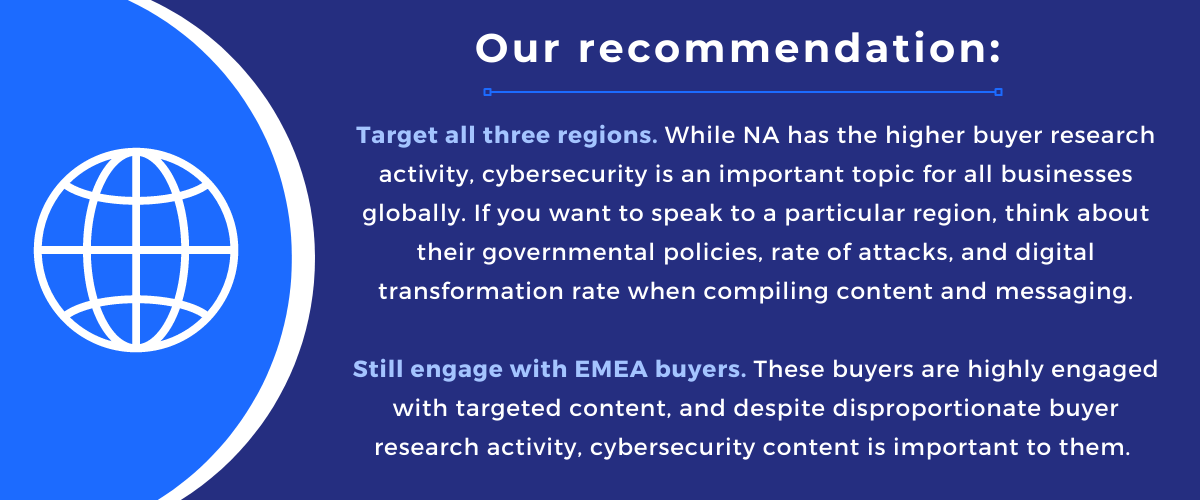
Who are the buyers?
Cybersecurity traditionally falls under the IT umbrella for an organization, with the buying process including members like CISOs (chief information security officers) and IT managers. Non-IT stakeholders are also included in the conversation. Gartner finds that 60% of CISOs will establish partnerships with key executives in sales, marketing, and finance in cybersecurity matters. Unsurprisingly, peer reviews are preferred content when researching solutions, and many senior IT decision-makers consume analyst research before investing in cybersecurity solutions. Board support for investing in cybersecurity solutions is also expected to increase, with Gartner predicting that 40% of Boards will have dedicated cybersecurity committees by 2025.
By Job Function
Cybersecurity is primarily an IT-based solution, so it’s no surprise that IT, Technology, and Security are most targeted and engaging with cybersecurity content. These areas need to be updated with trends and cybersecurity solutions so that they can optimize and maintain business continuity and digital environments.
Finance is also among the top 5 departments engaging with cybersecurity content, showing significant buyer research with an ML Score of 90. CFOs care about maintaining operations as a cost-saving measure and ensure that the investment in cybersecurity matches potential risks and the importance of an organization’s infrastructure, from financial systems to operations. When targeting persons in the finance department, cybersecurity solution providers should touch on operational cost topics and investments for infrastructure.
Our recommendation: Maintain active campaigns focused on the IT department. As the traditional overseers of business technology infrastructure, IT teams stay up-to-date on the latest trends, updates, and industry findings. By consistently engaging with them across ABM channels, you can establish trust and bolster your brand’s reputation.
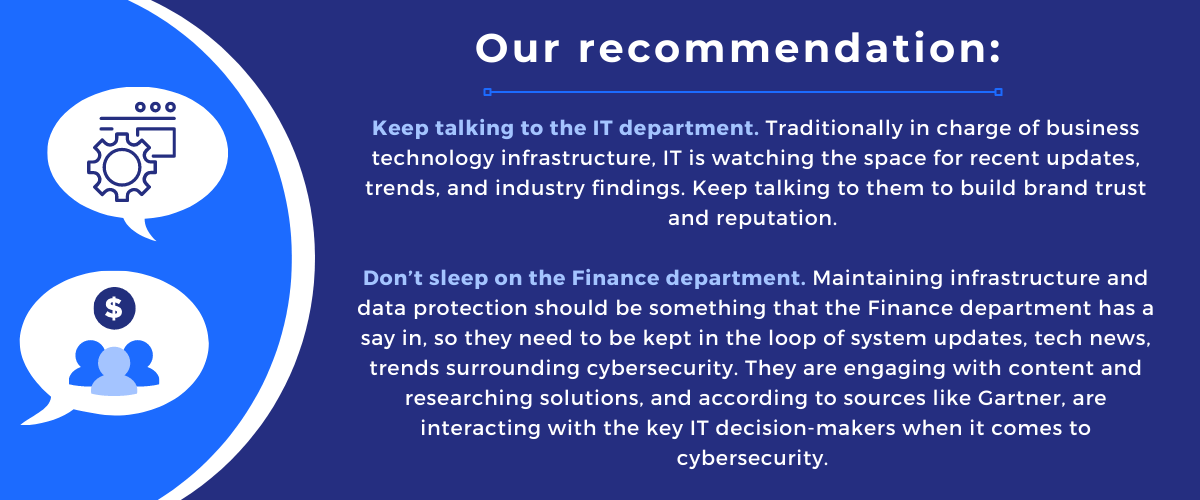
By Seniority Role
ML Insights reveals that the C-suite and Director are the top job seniorities for both targeting and engagement. Directors have been targeted more YoY, but Managers are the top seniority role increasing buyer research by 25%.
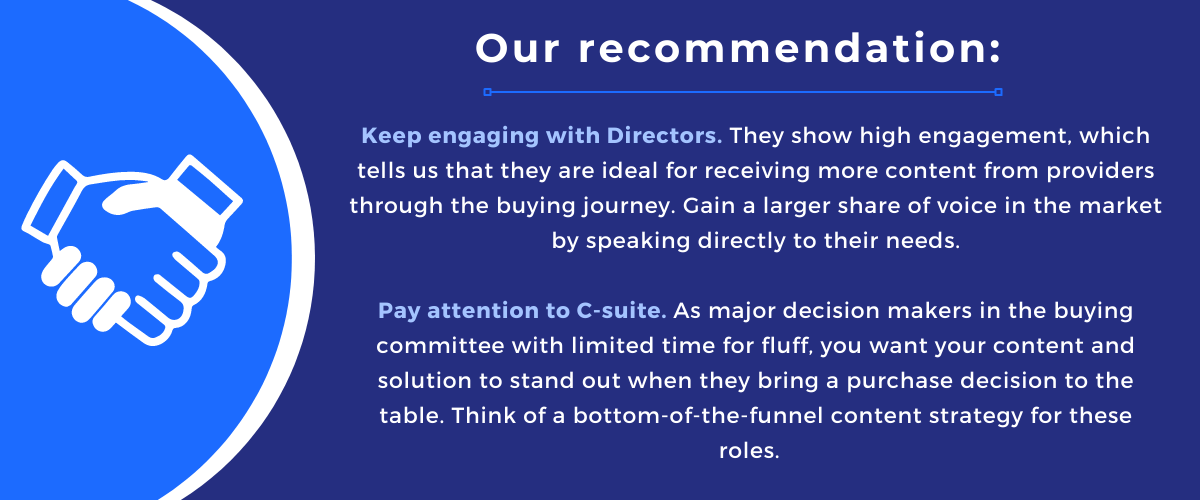
At Madison Logic, our commitment is to empower our customers to convert their best accounts faster. Request a demo today to learn how we can help you reach and connect with cybersecurity buyers through targeted content and messaging, all informed by our proprietary buyer intent data from within ML Insights.
